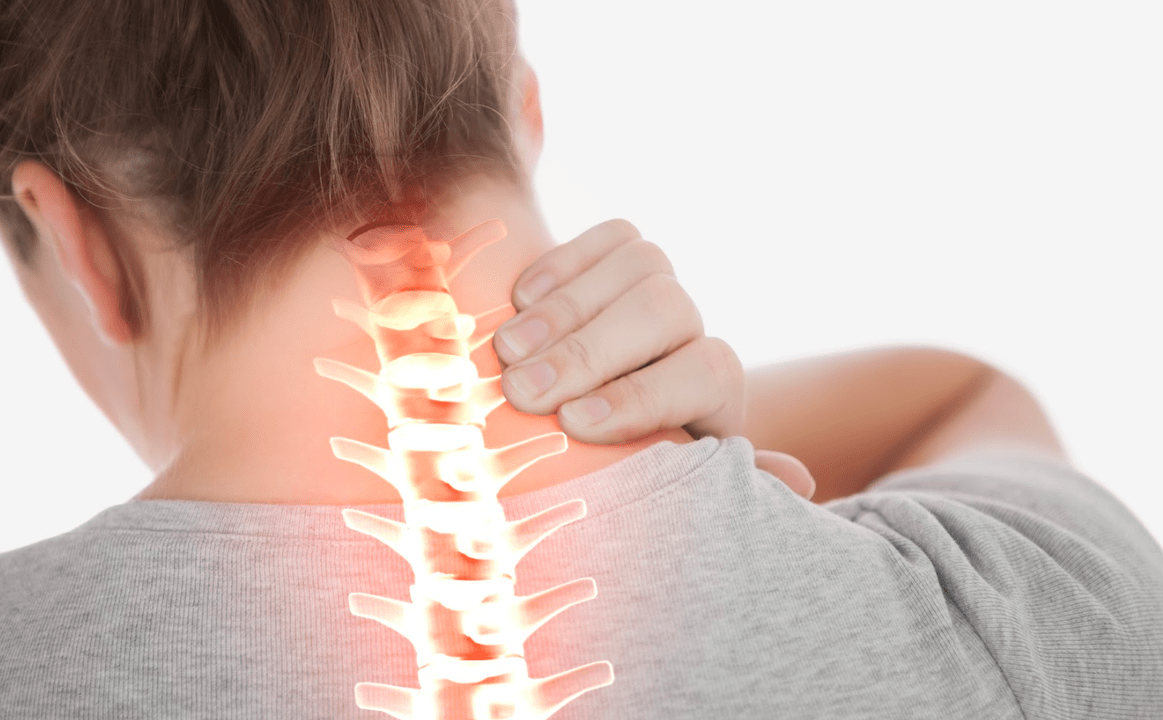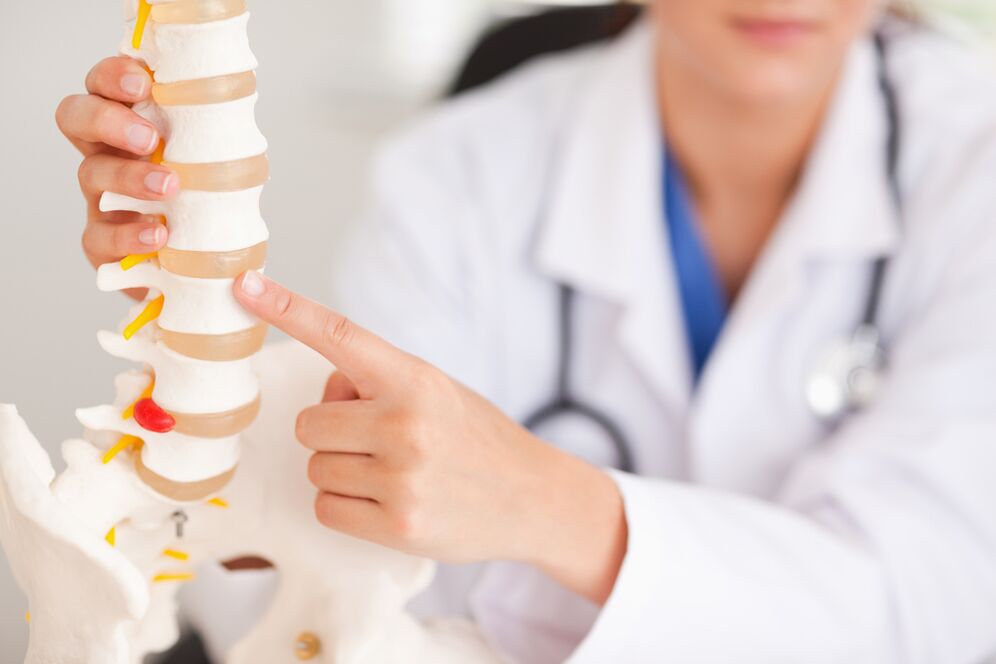Osteochondrosis is a degenerative-destructive lesion of the spine, which includes the defeat of the bodies of the vertebrae, the joint apparatus, the ribbon apparatus and the intervertebral discs between vertebrae. This disease is evenly frequently frequently in all countries - from 45 to 85% of the population suffer from this disease. The beginning of osteochondrosis occurs in patients over 30 to 35 years, but cases of earlier use of the disease are known. Men and women get sick with approximately the same frequency.
Causes

There is no uniform cause of the development of osteochondrosis. There are a large number of predisposing causal factors. The most important are as follows:
- Spine injuries (fractures, bruises, transfers);
- Hereditary disposition;
- Foot diseases that cause an overload of the spine - comprises flat feet, a different deformation of the foot, the valgus deformation of the foot;
- Wear long and unpleasant shoes for a long time (also causes overloading of the spine);
- Obesity and obesity;
- Age -related changes;
- Sitting lifestyle;
- Athletes who abruptly give up their training and their classes;
- Metabolic disorders;
- Spine curvature (kyphosis, lordosis, scoliosis);
- Professional features - lifting weight, frequent curves and body.
- Frequent and longer hypothermia;
- Stress;
- A specific climate, both at the place of residence and at work - low air temperatures and high humidity.
If the development of the disease is exposed to one or more causal factors, it begins. It is common to divide it into four main phases:
- The first stage. The amount of moisture in the core of the intervertebral disc has been removed, it becomes flatter, the distance between the vertebrae decreases. The cartilage is covered with minor cracks.
- The second stage. Due to the reduction of the distance between the vertebrae, the muscle and ligament apparatus of the vertebrae occurs. This leads to a pathological mobility of the vertebral bodies to their shifts.
- The third stage. Due to progressive processes in the spine, squeezing (lead) of the intervertebral discs occurs, a subluxation of the vertebrae.
- The fourth stage. Bone spikes (osteophytes) occur between the vertebrae that aim to eliminate the mobility of the vertebrae, the prevention of transfers. Over time, there are so many of them that those affected vertebrae completely lose their mobility. In this case there is a trauma of blood vessels and nerves near the vertebrae and leaves the spine.
The patient does not have in the first and last phase of the disease of clinical manifestations (pain).
classification
There are many classifications of osteochondrosis. Every doctor chooses the most acceptable. The following classifications are used most frequently:
Classification for the defeat of the spine:
- Cervical osteochondrosis;
- Thoracic osteochondrosis;
- Lumbale osteochondrosis;
- Crowning osteochondrosis;
- Extensive (common) osteochondrosis - affects 2 or more spine.
Classification by the degree of change in the intervertebral disc (radiological stages):
- 0 stage - there is no change in hard disk;
- 1. Level - Minor changes, including maximum internal tears;
- 2 levels - severe changes in the disc, while the outer surface is maintained;
- Level 3-the entire disc is fully affected (cracks with spread to the outer surface, the pane under the bodies of the vertebrae, etc. ).
Classification through clinical manifestations and degree of spine function:
- 1. stage - the functioning of the spine does not change, the patient has slight pain in the lesion;
- 2 levels - The function of the spine is disturbed (subluxes of the vertebral bodies occur, disc lead, clamping of the nerves), pain at the destruction point intensifies;
- Stage 3 - The spine is deformed, hernias of the intervertebral discs occur, significant pain;
- Level 4 - The patient is difficult to move, the mobility of the spine decreases, pain during the least movement. The patient receives a disability.
Symptoms of osteochondrosis

The symptoms of osteochondrosis depend on the damage area of the spine and the degree of the disorders occurring.
The following signs are characteristic of the expanded clinical image of the osteochondrosis of the cervical spine:
- Violation of visual acuity;
- Dizziness;
- Tinnitus;
- Flicker "fly" in front of the eyes and the appearance of colored stains;
- Hearing loss;
- Headache in the neck, temporal and parietal region that increases when the cervical spine is moved;
- Loss of consciousness;
- Snoring;
- Heiser the voice or their weakening;
- Dust and loss of sensitivity on the skin of the face, neck and hands;
- Tooth destruction;
- Blood pressure board.
For osteochondrosis of the thoracic spine, the following symptoms are characteristic:
- Pain in the heart that takes a long time, painful or pressing, often spicy, seams, spicy, patients can show a certain pain point;
- Daubiness of the skin in the chest, stomach and back;
- Pain in the spine, especially between the shoulder blades, is strongly expressed;
- Pain when lifting hands;
- Pain with sharp and deep breath and later inhale when exhaling;
- Pain, complaints and difficulties in tendencies in the body in every direction.
The following symptoms are characteristic of osteochondrosis of the lumbar and sacred spine:
- Pain in the area of lumbar and sacred spine (lumbargia), which are accessible in one or both legs and intensify with every movement of the spine in the affected area;
- Legs freeze for other parts of the body at a comfortable temperature;
- Almost constant tensions in the muscles of the back, especially in the lumbar area;
- A feeling of deafness, creeping goosebumps and tingling on the skin of legs and buttocks;
- Varicose veins on the feet;
- Violation of potency in men;
- Increased sweating;
- Dream of the skin on the feet;
- Irregular menstruation in women.
In the event of a longer and neglected osteochondrosis, if the affected vertebrae grumbles with each other, the patient is generally taken care of by the impossibility of movements in a certain spine, usually decreases or leaves it completely.
Diagnosis
First, the doctor carries out a survey and examination of the patient, which sets a preliminary diagnosis. Additional examination methods are assigned for confirmation. With osteochondrosis, they are only instrumental because the laboratory (tests) has no confirming changes.
The most important diagnostic methods include the following:
- X -Ray test. Allows you to determine the degree of damage to the vertebrae, their location and bone formations. With indirect methods you can determine the condition of bone channels and intervertebral discs.
- Computer tomography (CT). Enables you to determine the condition of the intervertebral discs, their structure and shape, deformation of the vertebrae and the compression of the nerve endings and roots.
- Magnetic resonance imaging (MRI). It enables smaller violations to be determined in the spine and is prescribed in cases where controversial problems remain the position of the CT.
- Ultrasound process. Allows you to identify the degree of blood circulation in the vessels that feed the spinal cord and other organs.
- Myelography. The method of radiography of the spine using a contrast matter. Allows you to identify hernias between the suspension tremblers.
Treatment of osteochondrosis
Conservative treatment
Conservative treatment methods are primarily used in the treatment of osteochondrosis. In this case, the approach should be individual and complex for each patient. Conservative treatment methods can be divided into 4 main groups:
- Drug treatment;
- Physiotherapy;
- Spa treatment;
- Diet (basics of the right nutrition).
Medicinal treatment of osteochondrosis

Medicines used in the treatment of osteochondrosis must be used in periods of exacerbations. They contribute to a decrease in symptoms and also influence some causal factors in developing the disease. The main groups of medication in the treatment of osteochondrosis:
- NSAID. Non -steroidal anti -inflammatory drugs have anesthetic, anti -inflammatory effects and also reduce the increased temperature of the affected tissue of the spine and their structures. In pronounced symptoms, the first days of exacerbation of the disease are prescribed in the form of injections. The frequency of use is 1-2 times a day. Then switch to tablet forms of medicinal products with a treatment rate of 10 to 30 days if necessary. The frequency of admission is 1 to 4 times a day. In addition, together with tablets and injections, ointments or creams, which are applied 1-3 times a day in the area of the spine on the skin.
- Musorelaxants. Preparations for this group are a great deal of handling of an increased muscle tone, relaxing cross -broken muscle fibers and the relief of the patient's condition. On average, the course of treatment is about 1 month. In the case of severe symptoms, treatment begins with injection forms of medicinal products. The dosage must increase with minimal and gradually until the therapeutic effect is achieved, which gradually reduces the complete cancellation.
Several other groups are used as additional medication:
- Vitamins. Accelerate the restoration processes of the tissue, normalize the nerve conductivity, accelerate the metabolism, etc. Almost always these drugs for osteochondrosis are prescribed in the form of injections, courses for 10 days. These are vitamins B1, B2, B6, E.
- Blood preparations. These drugs normalize blood flow in the veins and arteries, restore the muscle tone of blood vessels and restore the metabolism. Tablet freedom forms are mostly used. The duration of treatment with these active ingredients is between 1 and 3 months. Even in extreme cases, the injection of the drug is possible for the first 5-10 days with the subsequent transition to tablets.
- Glucocorticosteroids. They have anti -inflammatory, determined effects, improve the work of NSAIDS and muscle relaxants. Depending on the severity of the patient's condition, they are prescribed in the form of injections intramuscular or intra -fast or in the form of tablets for oral administration. The course of treatment is selected individually from several days to several weeks. The abolition of the drug should take place with a gradual decrease in the dosage.
- Biogenic stimulants. Accelerate the metabolism, stimulate the tissue control, reduce inflammation and swelling of tissues and much more. Most frequently used in injection form and somewhat less often in the form of tablets or other forms for oral administration. Depending on the severity of the disease, the course of treatment can be between 1 week and 2-3 months.
Physiotherapeutic treatment of osteochondrosis
Physiotherapeutic measures in combination with medicinal products enable you to speed up recovery processes and to expand the remission duration if they are used outside of exacerbations. There are many physiotherapy methods, and most of them are practiced well in the treatment of osteochondrosis:
- Electrophoresis. Depending on the drug used in this procedure, an analgesic effect is achieved. Metabolism improved and the normalization of blood flow in those affected.
- Acupuncture (acupuncture). With the help of special finest needles and their effects on active points on the patient's skin, an analgesic effect is achieved, the relaxation and metabolic processes are stimulated and the inflammation decreases.
- Magnetotherapy. Reduces pain, swelling and inflammation of tissues, accelerates the nervous conductivity, normalizes metabolic processes normalizing
- Manual therapy. Mobility is restored in the joints of the spine, the pain syndrome is reduced.
- Massage. Normalizes the muscle tone, eliminates back pain and restores the nervous conductivity.
- Training therapy. Restoration of the mobility of the spine, a reduction in pain, the restoration of the usual lifestyle, the strengthening of the muscle frame of the back, relaxation of the back muscles, acceleration of the metabolism.
- The traction of the spine. The mobility of the spine is restored, the progression of the disease and the development of complications is prevented and anesthetized.
- Laser therapy. Improves blood supply, stimulates tissue regeneration, reduces pain and inflammation, reduces swelling of the spine.
- Thermotherapy. Anaesthesia effect, normalization of blood flow and lymph by blood vessels, a decrease in inflammation in the tissue, acceleration of restoring the cartilage.
- Mudreg (Peloid therapy). Reduces the pain in the spine, reduces muscle spasm, reduces slightly inflammatory processes, improves blood supply and metabolism.
A patient can be prescribed for 1 physiotherapeutic event and its complex. It depends on the severity of the osteochondrosis process and the associated pathologies. The duration of the course of treatment is an average of 10-15 days. It is recommended to repeat 3-4 times in the course of the year. It is therefore possible to reduce the frequency of exacerbations and the course rate of osteochondrosis several times.

























